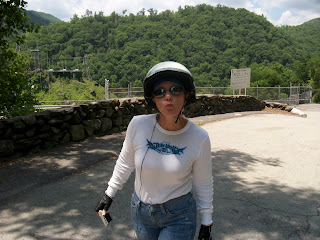In 1819 the Cherokee settled in this area to form a community, they called it New Echota. The Cherokee were pressured by the government and area settlers to conform and adopt American ways. They became one of the "Five Civilized Tribes" along with the Choctaw, Chickasaw, Creek and Seminoles. They assumed if they adopted American ways and became "Civilized" the American govt would leave them alone and let them keep their land. Being "Civilized" meant they needed to become Christian, Educated, form a government and farm the land. And so they did.

 A middle class farming family had a larger home, smoke house, barn and other outbuildings
A middle class farming family had a larger home, smoke house, barn and other outbuildings Small gardens
Small gardens Larger house
Larger house Inside was about 20' x 20'
Inside was about 20' x 20' Larger bedroom with spinnin wheel
Larger bedroom with spinnin wheel With a larger land lot size.
With a larger land lot size.  They had council meetings and met regularly
They had council meetings and met regularly Inside the Council Meeting house
Inside the Council Meeting house Looking at the Printing House and Vann's Tavern
Looking at the Printing House and Vann's Tavern The had a printing house where they printed a newspaper both in English and Cherokee. Copies of those newspapers still exist today.
The had a printing house where they printed a newspaper both in English and Cherokee. Copies of those newspapers still exist today. A printing press
A printing press Printing office
Printing office Vann's Tavern where folks could come for sundries, lodging, gossip and news.
Vann's Tavern where folks could come for sundries, lodging, gossip and news. 


 The Cherokee Supreme Court. They had their own set of laws and a Constitution
The Cherokee Supreme Court. They had their own set of laws and a Constitution
 The Worcester House. Rev Samuel Worcester, a Presbyterian minister came to New Echota to minister to their religious needs. He started a church, school and served as a postmaster. He was arrested by the state of Georgia in 1831 for not obtaining a permit to reside within an Indian Nation. He is jailed for quite some time. He appeals his case to the U.S. Supreme Court (Worcester v Georgia 1832) and wins.
The Worcester House. Rev Samuel Worcester, a Presbyterian minister came to New Echota to minister to their religious needs. He started a church, school and served as a postmaster. He was arrested by the state of Georgia in 1831 for not obtaining a permit to reside within an Indian Nation. He is jailed for quite some time. He appeals his case to the U.S. Supreme Court (Worcester v Georgia 1832) and wins. 

 His house welcomed all who came and his hospitality was well known. However, President Andrew Jackson and the State of Georgia decided in 1832 to confiscate the land when gold was found on it. Pres. Andrew Jackson ordered the forced removal of the Cherokees and all other Five Civilized Tribes, to Oklahoma land. This forced march became the Trail of Tears.
His house welcomed all who came and his hospitality was well known. However, President Andrew Jackson and the State of Georgia decided in 1832 to confiscate the land when gold was found on it. Pres. Andrew Jackson ordered the forced removal of the Cherokees and all other Five Civilized Tribes, to Oklahoma land. This forced march became the Trail of Tears. 






































